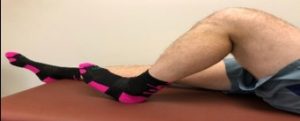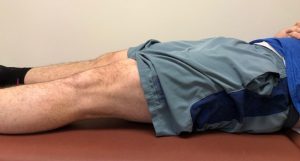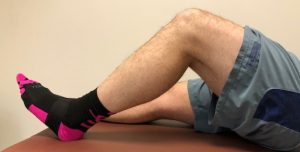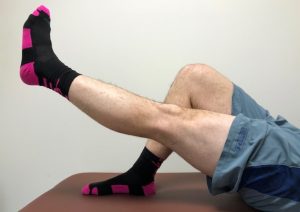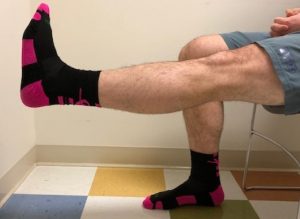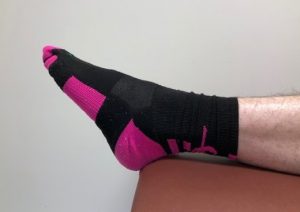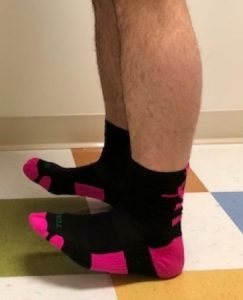PHYSICAL THERAPY
- A physical therapist may be coming to your home to work on your mobility.
- Small short walks are beneficial.
- If you have any animals, taking them for short walks is beneficial to work that new joint. You should not be responsible for the leash. This could be a significant tripping hazard.
- Keep leg elevated when seated.
- You can start practicing with stairs. You need to think “UP with the GOOD, DOWN with the BAD.”
- Go UP the stairs using the non-operative leg, and go DOWN with the operative leg. Go one step at a time. This is for safety and stability. Most of your weight will be placed on the non-operative leg.
- Please use hand rails for safety.
- Sleeping:
- Side sleeper: place a pillow in between your legs.
- Back sleeper: place a pillow under your heels.
- Don’t place pillow directly under knee if knee replacement, this will make it more difficult to straighten the knee completely.
Early mobility, gentle exercises for you to perform following your surgery are recommended. It is important for you to take short walks outside or around your home several times a day and to not remain sedentary for more than 45 minutes at a time. Typically, you will complete 10 to 15 repetitions of each exercise, two to three times each day. While you will be focusing on the leg with the hip or knee replacement, performing the exercises with both legs is a good idea. Please always follow all of the precautions explained to you by your physician and therapist.
Rehabilitation After Total Shoulder Replacement Surgery
Even though shoulder joint replacement is less common than knee or hip replacement, it is just as successful in relieving joint pain. The key to your recovery after surgery is managing pain and following your surgeon’s specific instructions.
After surgery, your operated arm will be immobilized at your side with the use of a specialized sling which has a supportive pillow. Based on the surgical technique, you may begin gentle therapy on the first day post-operatively. Sling immobilization is enforced during the early rehabilitation phase. However, your surgeon may allow you to begin a specific and personalized exercise program. An occupational therapist will instruct you on which exercises you may begin for your shoulder, elbow wrist and/or hand. Progression to more advanced exercises to improve strength and flexibility will occur under the direction of your surgeon.
Our goal is to help promote function and protect your new shoulder from the wear and tear of daily activities. The occupational therapist will teach you how to manage your sling (taking it off and putting it on) and perform modified bathing, dressing, undressing and toileting since you will be using only one arm for a while. If needed, physical therapy will also work with you to ensure independence with transfers and ambulating.
Rehabilitation After Total Knee or Hip Replacement Surgery
Quad Sets
While lying on your back in bed, press your affected knee into the mattress and tighten your muscle on the top of your thigh. Hold for a count of 5-10 seconds.
Ham Sets
While lying on your back in bed, keep your affected leg bent and the other leg straight. Tighten the muscle on the back of your affected leg. Push the heel down into the bed with the affected leg. Hold for 5 seconds.
Gluteal Sets
While lying on your back in bed, squeeze your buttock muscles together and hold for a count of 5-10 seconds.
Heel Slides
While lying on your back in bed, bend your affected knee and slide your heel to your buttock. Slide it back out straight. Tie a plastic bag around your foot if it makes the foot easier to slide.
Straight Leg Raises
While lying on your back in bed, tighten your thigh muscles and lift the affected leg up several inches off the bed. Keep your knee straight and toes pointed up. Hold the leg up for 5-10 seconds and then lower it back onto the bed. Do not continue if this hurts your lower back.
Lying Knee Extension
Lie on your back in bed. Place a towel rolled up or in a ball under the lower part of your thigh on the affected side. Lift your foot and straighten knee. Do not raise your thigh off the rolled up towel or ball.
Sitting Knee Extension
While sitting in a chair with your back against the chair back, straighten your affected knee and hold for a count of five to 10 seconds. Lower your leg back down to the floor.
Ankle Pumps
While sitting in a chair or lying on your back in bed, straighten your knee and slowly push your foot forward and backward. Repeat 20 times with both ankles, every hour while awake.
Heel Raises
While standing up, hold on to the back of a chair. Raise up on your toe.
Toe Raises
While standing up, hold on to the back of a chair. Raise your toes off the ground. Slowly lower toes back to the ground.
Standing Knee Flexion
While standing up, hold on to the back of a chair. Bend your knee back behind you. Slowly lower it back to the ground.
Knee Raises
While standing up, hold on to the back of a chair. Raise one knee at a time as if marching in place. Do not lift your knee higher than your waist. Hold your knee up for 2-3 seconds. Slowly lower it back to the ground.
Standing Hip Abduction / Adduction
While standing up, hold on to the back of a chair. Move one leg out to the side. Keep hip, knee, and foot pointed straight forward. Slowly lower it back down to the ground.



